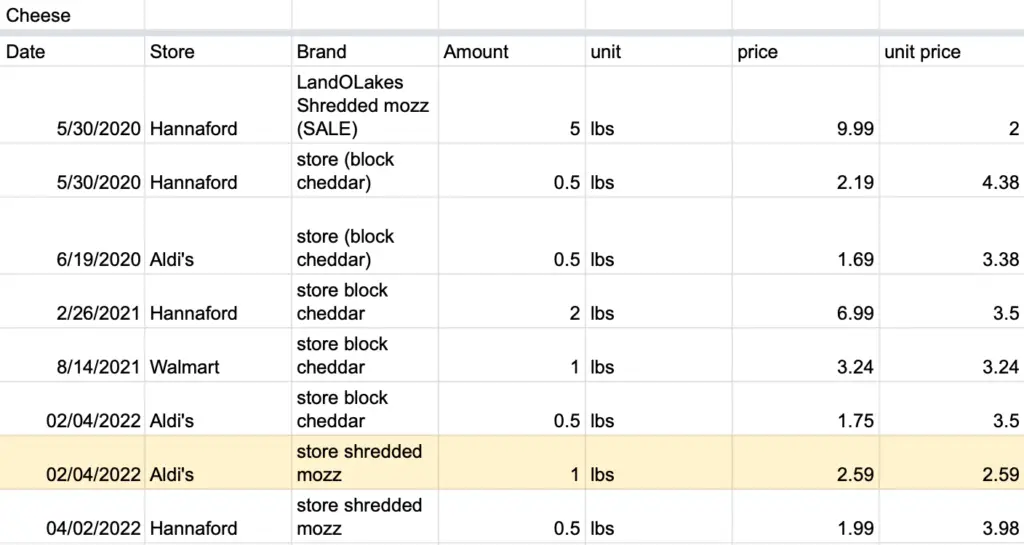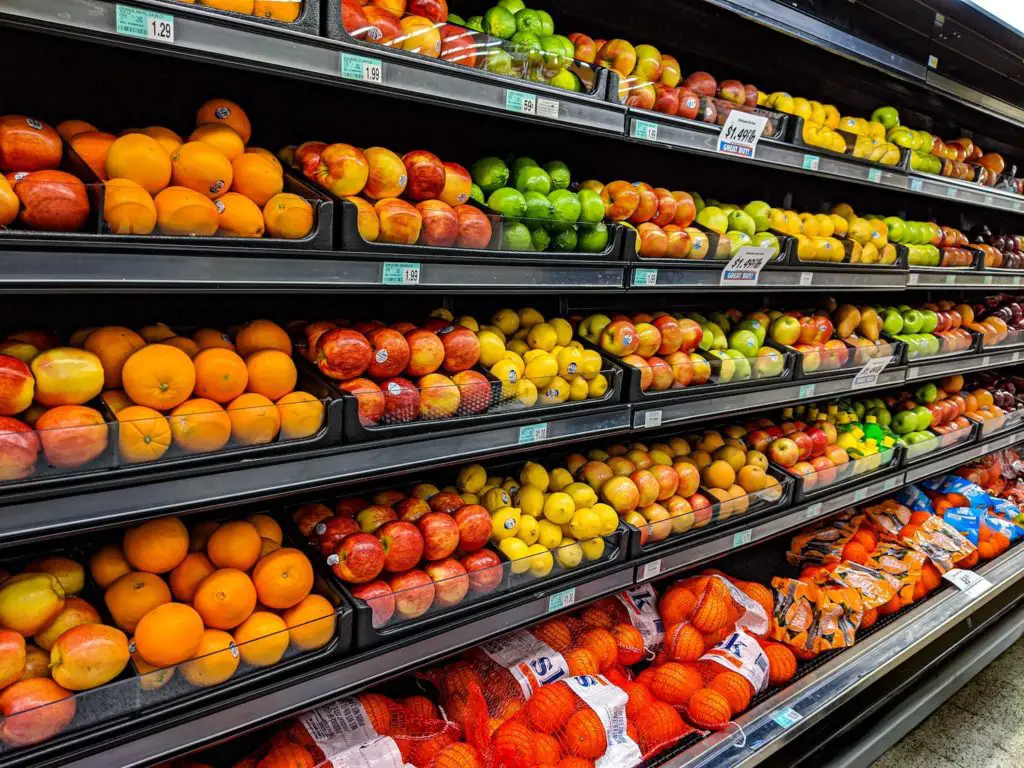Have you ever wished for a magic book that just tells you exactly what the best price is for groceries? I wish such a thing existed. I’d love to just give you a list that says “here’s the most you should ever pay for milk” or “this is the best sale price for broccoli” or whatever, but I can’t.
Why? Because exact prices vary WILDLY depending on where you live.
Here’s an example: I used Walmart.com and looked at their in-store prices on the same day for their Great Value 1 gallon, whole milk. These are the prices for the exact same item, depending on where I set the ‘home store’ location:
- Portland, OR- $2.30
- El Paso, TX- $2.76
- Nashville, TN $3.02
- Long Beach, CA- $3.49
- Miami, FL- $3.61
- Honolulu, HI- $5.44
There are currently a few apps which claim to function as a digital price book, but after some experimenting and investigating, there aren’t currently any I can recommend.
Instead, I’m going to teach you how to create your OWN grocery price book, which is an important part of learning to how to save money on groceries. With a grocery price book, you can learn what’s average for your area, and what’s a legitimately good deal.
So what is a grocery price book?
The grocery price book was invented by Amy Dacycyzn (known affectionately around here as St. Amy), author of the book The Complete Tightwad Gazette. In her long-running newsletter, she described her price book as her main method for feeding her family affordably. In 1991, she regularly spent $180/month to feed her family of 8. In today’s dollars that’s only $362- for EIGHT people. So yeah, this method is tried and true.
Basically, a price book is a way to save information about the price of specific groceries for easy comparisons. It includes information like:
- Date
- Store name
- Brand
- Size / unit of measurement
- Price
- Overall unit price
For example, here’s a snapshot from the ‘cheese’ section of my own price book:

You can see I have entries from 2020, 2021, and 2022 all showing the prices of the same products. For example, I can see that block cheese at Aldi’s has gone up $0.12 in two years.
I can see also what’s the historical best price cheese in my area, any sales I noted, and which store has the best price on an item.
When I buy a 1/2 lb of cheese, I simply double the price to get the ‘1 lb unit price.’ That unit price is the column where you compare everything.
Why should you keep a grocery price book?
To save $$$
At the end of the day, you keep a price book to save money. If you try to rely on your memory for the best price of food, you’ll easily get duped at the grocery store. Without one, you might assume that every sale is equally good or that your favorite store has all the best prices on everything.
To feel you have control over your food budget
The most important part of any grocery shopping strategy is sales. Knowing when sales will hit means you’re no longer at the mercy of your store to have a sale in order to stay in your food budget.
Sales are the store’s way of getting you in the door, hoping you’ll overspend on other items to make up for it. But even if they have a sale on ground beef every six weeks, they might only have REALLY good sales on ground beef twice a year. A price book can tell you when the big sales happen, which cues you to stock up. You know when the sales happen so you can plan your cheap, home-cooked meals accordingly.
To learn which stores have the best prices on which products
No stores have the best price on all products. I know, that’s disappointing to hear. But because different stores cater to different people (organic people, Middle Eastern people, budget shoppers, etc), they price based on what brings their target customer in the door.
Some people want a price book to plan a route: stop at store A for these ten products, then go to store B for the next twenty products. Once a month they’ll hit up store C for a few specialty items with a long shelf life. Other people just want to know which store has the most cheap items so they can shop there.
To help keep track of inflation
Obviously, even a price book won’t be able to predict what global markets and food supply chains will do next. However, having my book by my side through the pandemic has been very reassuring. My price book has helped me answer the following questions for my family:
- Is the price of milk going up? (yes)
- Everyone’s saying meat is getting crazy expensive, but is it? (yes)
- Didn’t that box of cereal used to be bigger? (yes, but now it’s smaller and still $2.50)
- Is EVERYTHING getting less affordable? (no)
How to make a grocery price book
I’ll be honest, you need to invest time to make a quality grocery price book. I estimate it took me 10 hours of hands-on time to first set mine up (spread out over the course of a month). After that, it’s taken me maybe one hour total since (18 months later) for upkeep and additions.
But consider this: using the USDA Cost of Food Reports, I estimate my total savings thanks to my price book is somewhere around $11,000 spread out over two years. So you could say my per-hour wage for that 11 hour investment was about $1,000/hr (and it only goes up every week).
You, however, will not need to spend even 10 hours setting up your price book, because I’ve done it for you! If you want your free downloadable template, you can claim it from the top of this article. Then, come back here so I can walk you through the rest.

Step One: List Favorite Products
Before you can compare grocery store prices, you need to have a list of items to compare.
Start by looking at your last grocery receipt and highlight 10 items you bought that you buy every week. For many people this might be bread, milk, bananas, etc. I’ve included dozens of common items in your downloadable book to get you started. (You can feel free to delete any that aren’t on your regular shopping lists!)
However, this is the beauty of a price book! If you buy kombucha, spam, or organic soy milk every week, you can use those products instead.
Step Two: List Local Food Stores
There might be more than you think. For instance, I basically lived in a town for four years before learning there was an Asian grocery store I passed every day. And they had AWESOME prices on produce!
Now, you don’t have to list absolutely everywhere that sells food. But I’d consider looking at at least three or four of the following types if they were in my area:
- Membership Bulk stores (Costco, BJs, Sam’s Club, etc)
- Superstores (Walmart)
- Mid-sized grocery stores (Albertson’s, Meijer, Piggly Wiggly)
- Organic, Natural type stores (Whole Food’s, Trader Joe’s)
- Discount supermarket chains (Aldi, Lidl, WinCo)
- Salvage stores
- Ethnic/international grocery stores
- Warehouses
- Co-ops
- Farmers, local bakeries (for day-old bread and ‘ugly’ produce)
- Online subscriptions (Amazon, Misfit Market, etc)
Step Three: Compare Grocery Store Prices
The way I see it, there’s two ways you do the comparison part of this process: the couch potato method and the adventure method. You’ll probably want to do a combination of these.
For the couch potato method, you’ll need to grab your phone or laptop and get comfy. Pull up each of your favorite, local retailers on a separate tab or app (if they have an online database with current, in-store prices). Then, look up their prices for each of your 10 items. Don’t forget to check which of multiple sizes has the best price! In my area, the 1 lb cheese is usually cheaper than either the ½ lb or 2 lb blocks of cheese.
If some of your local food stores don’t have apps or websites with complete prices, you’ll need to take the adventure method and go inside the stores. Instead of looking suspicious, spending tons of time typing prices into your phone, I suggest taking pictures. Make sure each picture includes all relevant info: product, size, price, and brand. Then, when you get home, you can flip through your photos and type in all relevant data into your book.
Step Four: Update Your Grocery Price book & Profit
And that’s it! You’re done! Of course, you can and should keep adding to your price book over time until you’ve accumulated the prices for other products. Ones you buy often or ones that are fairly expensive are good candidates to eventually add.
As you grocery shop over the next few months, you’ll also want to note whenever you find a big discount on a product, or when it goes on super sale. Then you’ll be able to check back at the same time the following year and check if you’ve discovered a pattern.
Want to see me walk you through all this in a video? Here you go:
Remember to grab your free, editable grocery price book template! That way, you can skip the hours of work you’d spend formatting your price book. 🙂
